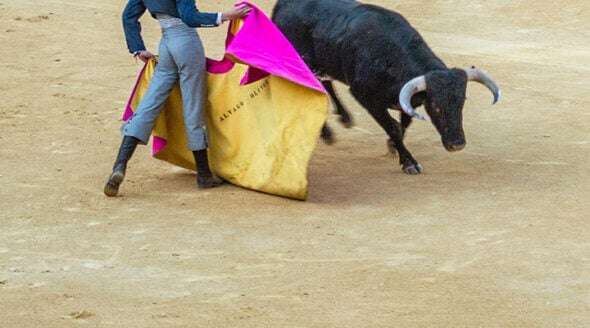Free Humane Education Materials
Share the World
This cross-curricular pack for key stages 1 and 2 remains popular among teachers and pupils. It consists of a 28-minute video that explores the amazing abilities of the animals with whom we share this planet, a resource book with animal stories for teachers, poetry, lesson plans and a full-colour A1 wall poster.
Citizenship: Animals and Us
This pack contains eight lesson plans for key stages 1 and 2, examining how animals’ lives interact with our own. The lesson plans focus on issues including the role of zoos, companion animal care and elephants in captivity.
Through these lesson plans, pupils will learn how to evaluate information and opposing views, appreciate animals and treat them with care and respect, make choices within a moral framework and examine how animal issues are portrayed in the media.
Animals in Today’s Society
Written for key stages 3 and 4, this pack contains eight lesson plans that encourage pupils to explore animal issues, including the arguments for and against whaling, meat production and animal experimentation.
Through these lesson plans, pupils are encouraged to conduct independent research, explore and give voice to their opinions about a range of issues, question existing practices of animal use worldwide, and make personal choices within a moral framework.
Just Choices
This pack, suitable for key stages 3 and 4, explores four social justice movements: women’s rights, racial equality, environmentalism and animal rights. The accompanying pack provides four lesson plans to help teachers explore social justice movements in Britain and is most suited to English, citizenship and history classes. Teacher’s notes accompany the pack.
GSCE English: Animal Rights
This pack contains eight lesson plans designed for the British GCSE English curriculum. Using animal issues to stimulate work, pupils will use and develop their reading, researching, listening, writing, speaking, analysing and debating skills.Using these lesson plans, teachers can ask students to analyse provocative poetry, write creatively about an animal they have known, present a talk about factory farming and listen to a passage by chimpanzee expert Jane Goodall.
Let’s Ask the Animals
Perfect for use in science lessons, this video explores the similarities between humans, pigs, chickens, cows and sheep. It uses video footage of animals to demonstrate that animals learn from experience, use their senses and need companionship and exercise – just as humans do.
*RECOMMENDED FOR SCIENCE TEACHERS!*
Author/Producer: The Association for the Study of Animal Behaviour (ASAB)
Suggested Age Range: Ages 7–10
Description: A 22-minute video, with discussion breaks at 9, 13 and 17 minutes
Suitable for the Following Subjects: Science, Citizenship, PHSE, English
Suggested Uses: Show the video to your students, then lead a classroom discussion.
How to Order: You can watch the video online or you can obtain the DVD by contacting the Association for the Study of Animal Behaviour.
Description: Let’s Ask the Animals explores the similarities between humans, pigs, chickens, cows and sheep in a fun and engaging manner. Using video footage of animals, it demonstrates that animals learn from experience, use their senses and need companionship and exercise – just as humans do. It also shows scientists from leading veterinary schools working with animals, revealing fascinating facts about animal behaviour. With suitable breaks for discussion and classroom activities, the video helps promote appreciation and respect for animals by emphasising our shared physical and behavioural characteristics.
Stimulus Response
Featuring scientists from Britain’s leading veterinary schools, this unique video teaches the five steps of the stimulus-response pathway by using examples from animals’ lives. The video is particularly useful for science lessons and is accompanied by a teachers’ booklet and student worksheets.
*RECOMMENDED FOR SCIENCE TEACHERS!*
Author/Producer: The Association for the Study of Animal Behaviour (ASAB)
Suggested Age Range: Ages 13–18
Item Type: Video, teachers’ guide, worksheets
Description: A 26-minute video, with discussion breaks after 5, 8, 14 and 19 minutes; a 12-page teachers’ guide; two reproducible activity sheets
Price: Free for teachers
Suitable for the Following Subjects: Science, Citizenship, PHSE, English, RE
Suggested Uses: This video is designed primarily for science and psychology teachers, but it can also be valuable to educators in providing lessons in personal and social development, character education, humane education and debate.
How to Order: You can watch the video online or you can also obtain the DVD by contacting the Association for the Study of Animal Behaviour.
Download the PDF versions of the teachers’ guide and worksheets:
Description: Featuring scientists from Britain’s leading veterinary schools, this unique video teaches the five steps of the stimulus-response pathway by using examples from animals’ lives. Viewers will see how pigs perceive stimuli in the first moments of their lives, watch hens run obstacle courses to show that they have the mental ability and coordination to learn from videos, and learn about calves’ internal and external effectors. The video also shows the ways in which these animals are able to respond to the stimuli in their environments.
Together, the video, teachers’ guide and worksheets provide a fun and interactive way for students to explore the following subjects:
- The five steps in the stimulus-response pathway
- Animals’ senses and the difference between their primary and secondary senses
- The creation of ethical and effective experimental designs to test hypotheses on animal behaviour
- Interpreting data from experiments to draw conclusions
- Methods of learning, including habituation, conditioning, observation and trial and error
- Using information about animal behaviour to debate the ethics of factory farming
We recommend that educators review all videos before showing them to students.

